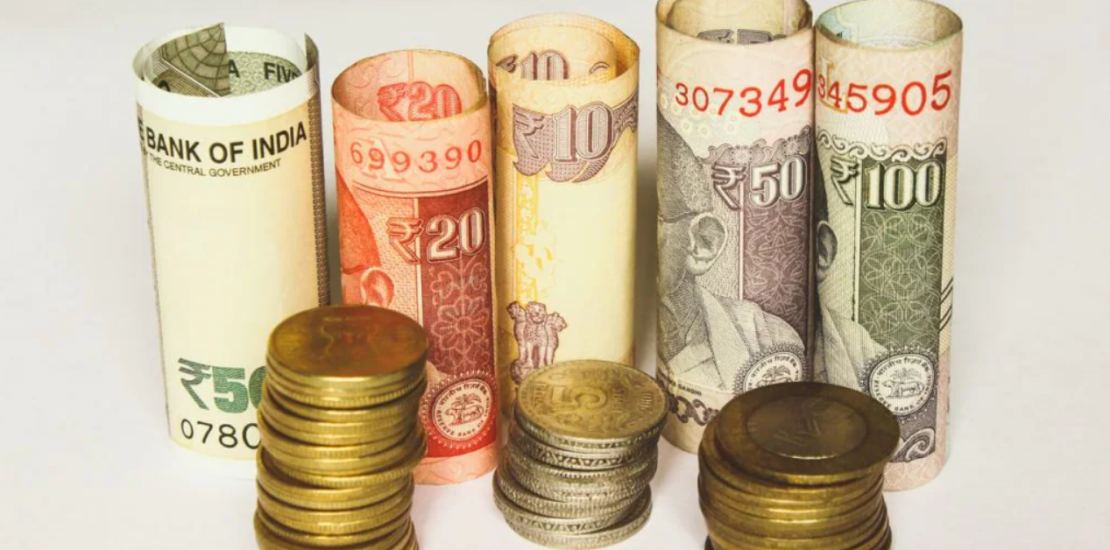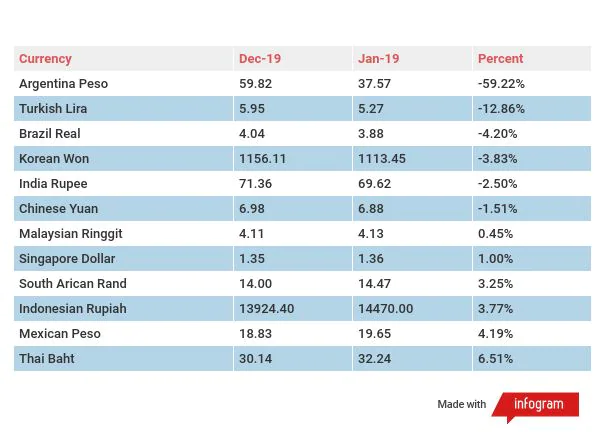- December 31, 2019
- Posted by: Amit Pabari
- Category: Economy

Globally, emerging market currencies have been on a rollercoaster rise driven by the US-Sino drama. As we glance through 2019, most of the Asian currencies had depreciated against the dollar. Amongst the highest was Argentina Peso whose depreciation comes majorly from the domestic crises and higher debt burden; followed by the sequence given below. There were a few exceptions like Thai Baht which registered a significant appreciation of 6.51 percent, followed by Mexican Peso appreciating by 4.19 percent, all in absolute terms.
However, the depreciation of Asian currencies mentioned above clearly signifies that it is majorly impacted due to US-China trade war which is still prolonging.
Domestically, in the third quarter of the financial year till date, the rupee had depreciated by 1.02 percent in absolute terms which is almost equivalent to
3-month dollar forward premium. Even after computing the year-end dollar demand from government agencies and oil refiners, the rupee hasn’t breached the 71.50 level before end-December. In December 2019 till date, the net portfolio outflow was $400 million approximately as compared with the net inflow of $2.26 billion in October and $3.23 billion in November. However, despite all of that, the rupee managed to remain stable, well in the range of 70.50-71.50 levels.
Going forward, the second tranche of debt auction swap which was to be conducted by the RBI today to the extent of Rs 10,000 crore shall lead the Indian 10-year sovereign bond yield to trade much lower targeting the 6.35-6.40 percent range over a period of 1-2 months from current 6.50 percent. The credit spread between the repo rate and the 10-year sovereign bond yield is currently at 135 bps which can contract further to about 125 bps possibly in the next 1-month period. The “operation twist” will lead to a moderate flattening of the sovereign bond yield curve and to some extent the Central Bank has achieved to reduce the long-term interest rates without cutting their repo rate currently at 5.15 percent. Overall, rising global oil prices combined with the higher food inflation shall keep the CPI inflation above 5 percent till the end of March 2020.
Gloomy economic outlook
Fundamentally, India’s macroeconomic indicators viz., low business confidence, de-growth in consumption, lack of private investment, slowdown in capital expenditure, financial sector complexity, higher unemployment rate, IIP and manufacturing sector are showing negative growth in the last four consecutive months thereby indicating the gloomy economic outlook. Adding to it, any additional reforms or stimulus measures announced by the government shall likely widen the fiscal deficit. However, the Union Budget presentation on February 1, 2020 shall give a clear picture to determine the extent of fiscal slippage and the action plan from the government to reduce the fiscal imbalance. All of the same can push IMF to lower the Q3 GDP growth to less than 4.7 percent and it seems quite possible that S&P may change the rating outlook from stable to negative.
RBI intervention
Historically, the RBI has been building reserves by buying dollars which are now peaking at $456 billion. And with that intervention on the buy side is more aggressive than on the sell side. The sell-side intervention is to balance the dollar outflow effect. But the same starts with the gap of a few sessions and by then the market takes the rupee down due to selling pressure from other participants. For eg. in the last couple of months, the RBI has bought dollars at every level right from 70.35 to even when rupee was at 71.80. On the other side, when rupee breached 72.00 mark and made its way to 72.40, we didn’t see any RBI intervention to get rupee down, evident from weekly reserves data which were rather on the uptrend. Whatever appreciation came after touching 72.40 was majorly driven by market forces.
Hence, the RBI intervention has been more supportive to exporters by protecting downside backing the same due to sluggish export figures. This policy serves the dual purpose of increasing import cover by building reserves.
For the first quarter of 2020, broad range of 70.50-72.50 remains intact, excluding any adversity arising out of the US-Sino trade war.
Amit Pabari is MD at CR Forex Advisors.
Leave a Reply
You must be logged in to post a comment.





